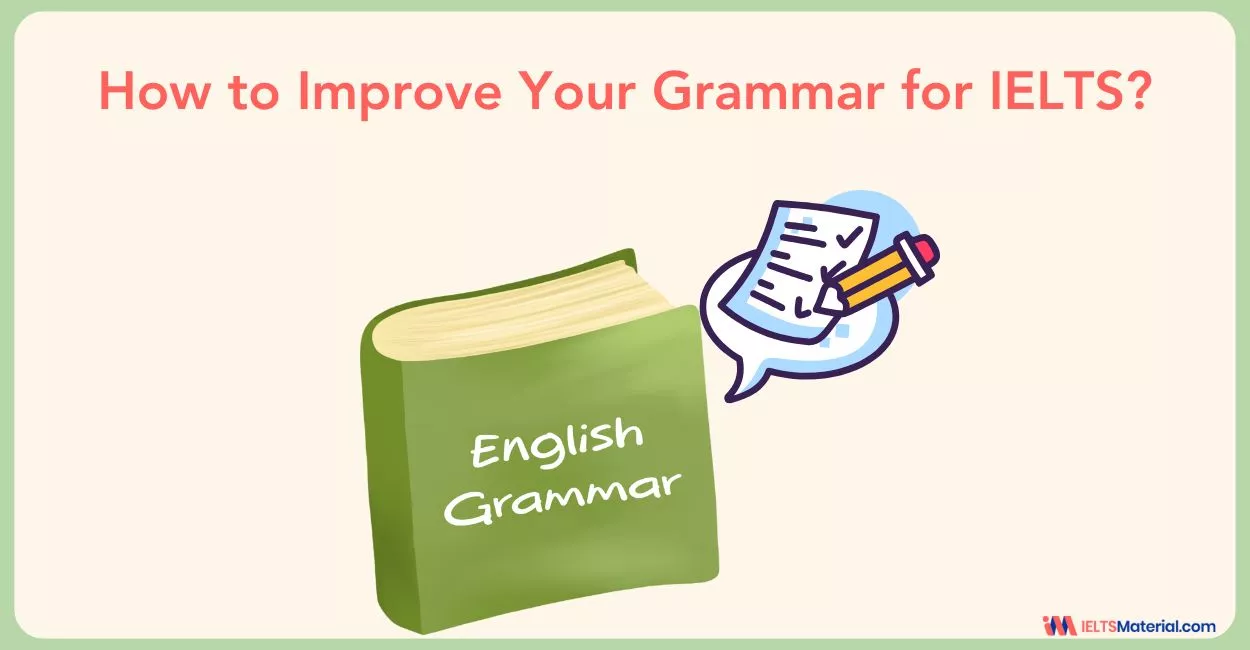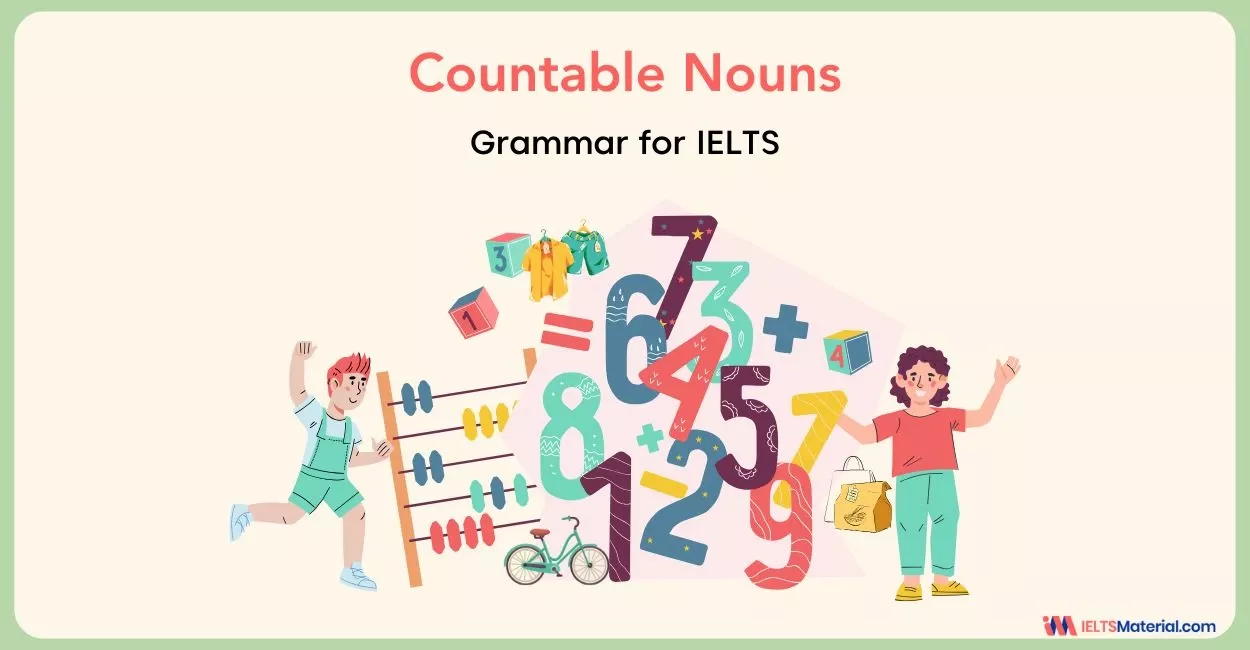Countable Nouns: Grammar For IELTS
7 min read
Updated On
-
Copy link
Master English countable nouns for IELTS Grammar with this detailed guide. Explore rules, singular vs. plural forms, examples, and challenging exercises with answers, perfect for learners & professionals preparing for Band 7 and above on the IELTS exam.
Table of Contents
- Quick Diagnostic Test for Countable Nouns
- What Are Countable Nouns?
- Key Features of Countable Nouns
- Forms of Countable Nouns: Singular and Plural
- Importance of Countable Nouns in IELTS
- Practice Exercises for Mastering Countable Nouns for IELTS
- Answer Keys for the Diagnostic Test and Exercises for Mastering Countable Nouns

Limited-Time Offer : Access a FREE 10-Day IELTS Study Plan!
Countable nouns are one of the most essential grammar concepts in English. They form the backbone of clear communication, especially in the IELTS exam, TOEFL, and academic writing. However, learners often confuse them with uncountable nouns or misuse them without articles and determiners.
In this blog, we will start with a diagnostic test to check your understanding, then explain the rules in detail with examples, and finally, end with challenging exercises with answer keys to help you master countable nouns for IELTS.
Quick Diagnostic Test for Countable Nouns
Choose the correct option for each sentence.
1 She bought ___ apples from the market.
a) a b) an c) some
2 I saw ___ interesting movie last night.
a) a b) some c) many
3 He doesn’t have ___ friends in this city.
a) much b) many c) an
4 There are two ___ missing from the box.
a) knife b) knives c) knifes
5 We discussed several ___ during the meeting.
a) criterions b) criteria c) criterion
Check the answers for this test at the end of the blog. If you got fewer than 4 correct, this blog will clarify the concepts for you!
What Are Countable Nouns?
Nouns that can be counted are called countable nouns (or count nouns). They can appear in singular or plural form. For example,
- Singular: one subject, a problem, one reason, a child
- Plural: five subjects, two problems, three reasons, eight children
Key Features of Countable Nouns
Besides learning the definition of countable nouns for IELTS, it is important to be aware of some special features of countable nouns. They are:
- Counting and Quantifying: Unlike uncountable nouns, countable nouns can be directly measured with numbers and articles (a/an). This means you can specify exact quantities in your sentences. For example, ‘three cats’, ‘an apple’, or ‘many books' all show clear amounts.
- Quantifiers: Count nouns can also be paired with quantifiers to show approximate numbers without being exact. Common quantifiers include ‘some’, ‘several’, ‘a few’, ‘many’, ‘a dozen’. For instance, you might say ‘some chairs’ or ‘a dozen eggs' to indicate an amount without needing a precise count.
- Subject–Verb Agreement: Countable nouns play a direct role in determining whether a sentence uses a singular or plural verb. A singular noun takes a singular verb (The cat is sleeping), while a plural noun requires a plural verb (The cats are playing). This is a key area of grammar tested in exams like IELTS.
- Individually Identifiable: Each countable noun refers to a separate, distinct object or entity. That means you can visualize and count them individually, unlike abstract or uncountable nouns. Examples include ‘desk’, ‘chair’, ‘student’, or ‘pen’, which exist as single units that can be added up.
- Used with Articles/Determiners: In English, singular countable nouns cannot stand alone; they require an article (a, an, the) or another determiner (this, that, my, every). For example, we say ‘a cat’, ‘the book’, ‘these chairs’ or ‘my pen’. This rule ensures sentences sound complete and grammatically correct.
Kickstart your IELTS grammar preparations now with our experts!
Book FREE IELTS online classes!
Forms of Countable Nouns: Singular and Plural
As mentioned above, countable nouns can exist in both singular and plural forms. Understanding the difference between the two is essential for correct grammar use, especially in IELTS writing and speaking. Let’s get started!
Singular Count Nouns
Singular count nouns refer to one single person, place, object, or idea. They are usually preceded by an article (a/an), or other determiners like this, that, my, his, her. In sentences, singular nouns always take singular verbs.
|
Correct Usage |
Incorrect Usage |
|---|---|
|
|
Exceptions in Idiomatic Expressions
Some singular count nouns can appear without articles:
- have dinner/in school/at home/at work
- by bus (by + transportation)
- by phone (by + communication)
Plural Count Nouns
Plural count nouns indicate more than one person, object, or entity. They typically end in -s or -es, though irregular forms also exist (e.g., man → men, child → children). In sentences, plural nouns always take plural verbs.
|
Correct Usage |
Incorrect Usage |
|---|---|
|
|
Regular Plurals
Most count nouns form their plural by adding -s to the singular noun.
| cat / cats | tree / trees | taxi / taxis | sweater / sweaters |
| schedule / schedules | course / courses | professor / professors | hat/hats |
Irregular Plurals
A few common count nouns have an irregular plural form.
| man / men | woman / women | child / children |
| fish / fish | tooth / teeth | foot / feet |
| knife / knives | thesis / theses | criterion / criteria |
| self / selves | analysis / analyses | datum / data |
| life / lives | alumnus / alumni | medium / media |
| half / halves | sheep / sheep | hero / heroes |
A few plural nouns do not have a singular form:
| glasses | pants | jeans | scissors | tongs | clothes |
Special Spellings of Plurals
A few types of count nouns form their plurals in a slightly different manner. Nouns ending in a CONSONANT + y form their plurals by changing the -y to -i and adding -es.
| library / libraries | lady / ladies | copy / copies | theory / theories |
This rule does not apply to nouns that end in a VOWEL + y.
| tray / trays | monkey / monkeys | survey / surveys | boy / boys |
Nouns ending in -s, -ss, -sh, -ch, -x, and -z add -es to form the plural.
| class / classes | bush / bushes | bench / benches | box / boxes |
Join our band 9 IELTS trainers today and crack IELTS in no time!
Book a FREE IELTS Demo!
Importance of Countable Nouns in IELTS
Although grammatical knowledge is not directly tested in IELTS, it is an important criterion for the IELTS Speaking and writing exams. So, here’s how your knowledge of the countable nouns will be useful for these two modules of the exam.
- Countable nouns are particularly useful in grammar because they allow candidates to demonstrate precision in their responses. In both the IELTS Writing and speaking sections, examiners look for a candidate’s ability to express ideas clearly with accurate grammar.
- Since countable nouns require correct use of articles (a, an, the), quantifiers (many, a few, several), and subject–verb agreement (The student is vs. The students are), they give test-takers opportunities to showcase grammatical range and accuracy, two important scoring criteria.
- IELTS tasks often involve describing people, objects, ideas, or situations that naturally rely on countable nouns. For example, describing ‘three solutions to a problem’ or ‘several advantages of studying abroad’ shows variety in IELTS vocabulary and proper pluralization.
- Using countable nouns correctly not only makes responses grammatically accurate but also more fluent, structured, and detailed, which directly improves coherence and lexical resource scores.
Level up your IELTS grammar preparation with our Exclusive Grammar Workbook!
Practice Exercises for Mastering Countable Nouns for IELTS
It is important to effectively use the theoretical knowledge of countable nouns for IELTS to make your responses in writing and speaking tasks more polished and sophisticated. Given below are some adverb exercises with answers for your practice and to improve your understanding of the use of countable nouns in IELTS grammar.
Exercise A: Correct the mistakes.
1 He bought a books from the shop.
2 My father has two childs.
3 I need informations about the course.
4 These criteria is not acceptable.
5 The boy brushed his tooths.
Exercise B: Fill in the blanks with the correct plural form of the word in the bracket.
1 I saw three ___ (woman) at the station.
2 There are many ___ (library) in this city.
3 The ___ (analysis) of the report are ready.
4 She is reading an interesting ___ (story).
5 He sharpened all the ___ (knife).
Exercise C: Choose the correct option.
1 She has ___ friends in her class.
a) much b) many c) an
2 The ___ of the problem is difficult to understand.
a) criterions b) criteria c) criterion
3 They need to buy some new ___.
a) clothes b) cloth c) clothing
4 There is ___ apple on the table.
a) an b) some c) many
5 He has ___ brothers, but no sisters.
a) some b) two c) both are correct
Answer Keys for the Diagnostic Test and Exercises for Mastering Countable Nouns
Diagnostic Test
1–c, 2–a, 3–b, 4–b, 5–b
Practice Exercises
Exercise A
- a book 2. children 3. information 4. are 5. teeth
Exercise B
- women 2. libraries 3. analyses 4. story 5. knives
Exercise C
1–b 2–c 3–a 4–a 5–c
To sum up, countable nouns are essential for accurate English grammar. They influence subject–verb agreement, require articles and determiners, and follow regular or irregular plural rules. By practicing with real examples and exercises, you will avoid common mistakes and become more confident in your writing and speaking. So, master countable nouns for a strong foundation in English whether you are a student, professional, or preparing for exams like IELTS and TOEFL.
Useful Links:

Start Preparing for IELTS: Get Your 10-Day Study Plan Today!
Develop your Grammar from our Grammar Topics

Kasturika Samanta


Nehasri Ravishenbagam
Recent Articles

Nehasri Ravishenbagam

Prity Mallick

Kasturika Samanta






Post your Comments